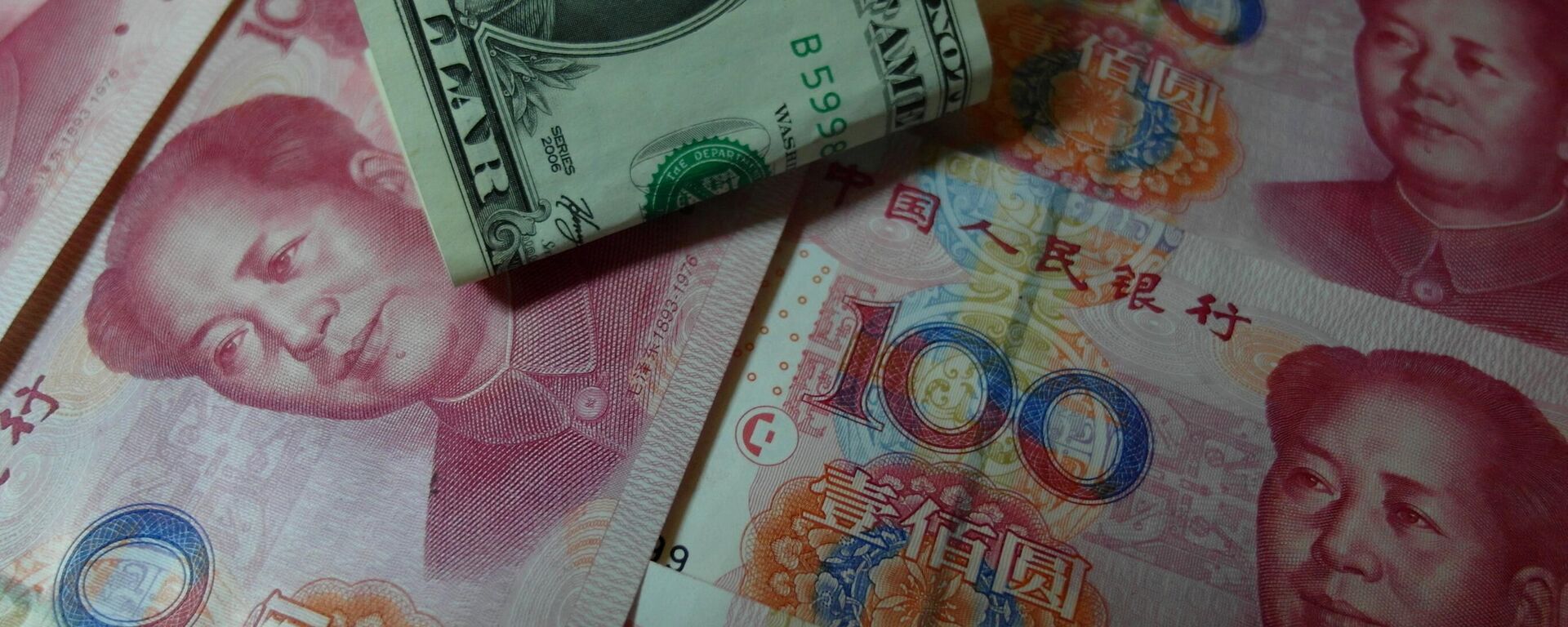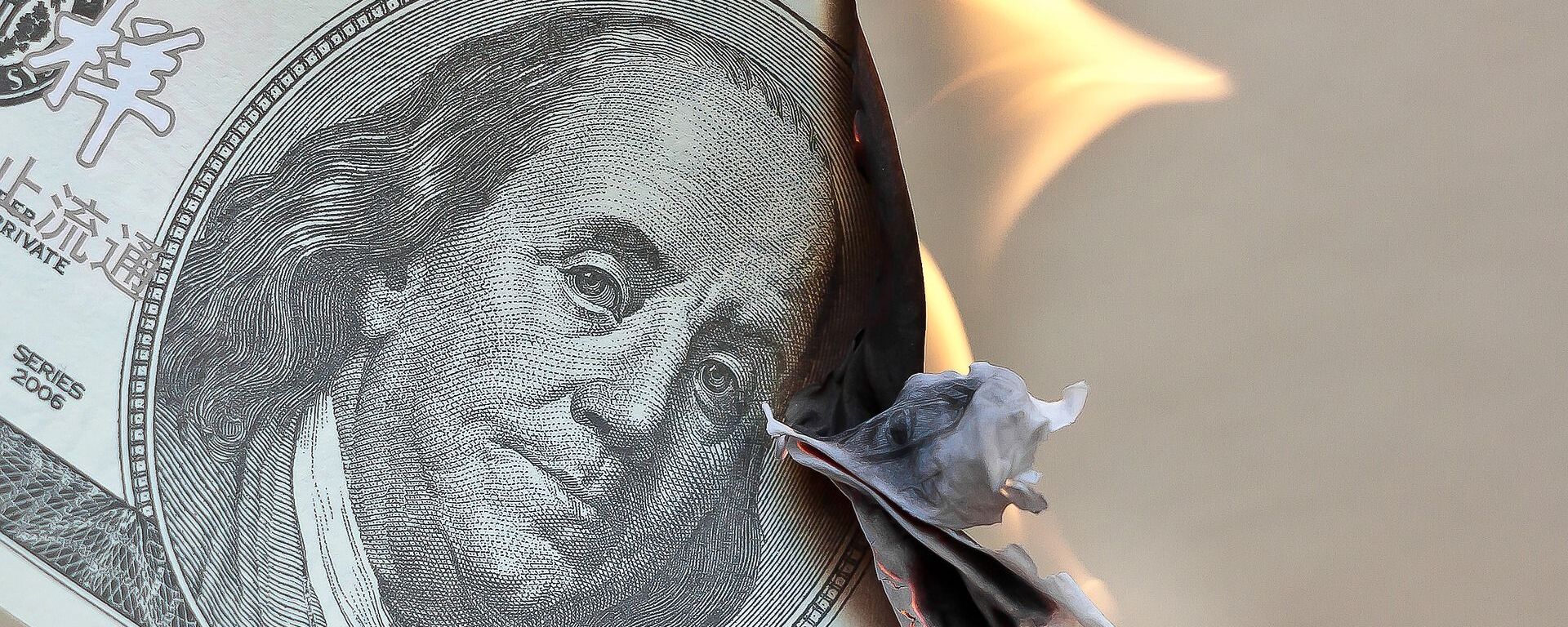https://sputnikglobe.com/20230521/emerging-market-investors-dump-dollar-denominated-debt-as-currency-continues-global-decline-1110499206.html
Emerging Market Investors Dump Dollar-Denominated Debt as Currency Continues Global Decline
Emerging Market Investors Dump Dollar-Denominated Debt as Currency Continues Global Decline
Sputnik International
The United States is facing what is shaping up to be a perfect storm of economic bad news, with higher than normal energy prices and inflation compounded by a spiraling debt crisis and fears of economic turmoil amid high stakes debt limit talks. Meanwhile, BRICS nations are brainstorming a way to de-dollarize the international trade order.
2023-05-21T11:17+0000
2023-05-21T11:17+0000
2023-05-21T11:17+0000
economy
brics
silicon valley bank
white house
republicans
washington
jim rogers
dollar
ditching dollar
dollar trade
https://cdn1.img.sputnikglobe.com/img/106176/34/1061763420_0:180:1920:1260_1920x0_80_0_0_fa49b19ca1c6d09fea654c4f46584010.jpg
Emerging market investors are slowly but steadily moving away from dollar-denominated debt and assets, instead preferring to park their hard-earned money into local currency bonds, an analysis by fund flow and asset allocation data provider EPFR Global has revealed.According to the company’s figures, investors pulled out a net $2.65 billion out of primarily dollar-denominated assets between January and April of 2023, but added a net $5.23 billion into local currency bond funds.Market analysts attribute the switch to attractive yields and falling inflation on local bond markets, and an increasingly unattractive dollar amid uncertainty surrounding interest rate-related volatility. The latter put a major dent in US Treasuries’ attractiveness to investors, and culminated in the collapse of Silicon Valley Bank in March, and panic among investors.Fidelity International emerging markets debt portfolio manager Paul Greer expects the trend of weakened demand for dollar-denominated debt and assets to continue for the rest of the year. ABP Invest chief investment officer Thanos Papasavvas says there has been a “clear divergence between emerging market local and hard currency bonds [typically dollars and other major Western currencies, ed.] over the past few quarters with local currency debt looking more attractive on a fundamental and valuation basis.”The trend of a cautious move away from the dollar, which continues to hold the coveted status of the world’s de facto reserve currency in trade, comes amid the growing risk of the US defaulting on its massive $31.8 trillion debt amid bickering between the White House and Republicans in Congress on federal spending and the debt limit.It also comes as the BRICS group of nations (Brazil, Russia, India, China and South Africa) brainstorm the creation of a common currency to serve as an alternative to the greenback in global trade, amid growing efforts by Washington to use its currency punitively against countries which fail to align to the Western economic and geopolitical order.Earlier this week, veteran US investor Jim Rogers told Sputnik that the dollar’s time as the world’s top currency is coming to an end amid the US’s lack of neutrality and concerns over the country’s creditworthiness.“Many people are starting to say: wait a minute, I don’t know if we want to use that money, because it will have a problem someday. But also, the world’s international currency is supposed to be completely neutral. Anybody can use it for anything [they] want. But now Washington is changing the rules. And if they get angry at you, they cut you off,” Rogers explained. “Even America’s friends are worried that something could happen to them.”
https://sputnikglobe.com/20230511/will-world-see-accelerated-de-dollarization-if-us-defaults-on-debt--1110262209.html
https://sputnikglobe.com/20230507/if-china-ditches-dollar-amid-emerging-new-trade-order-consequences-for-us-could-be-stark--1110163827.html
washington
Sputnik International
feedback@sputniknews.com
+74956456601
MIA „Rossiya Segodnya“
2023
News
en_EN
Sputnik International
feedback@sputniknews.com
+74956456601
MIA „Rossiya Segodnya“
Sputnik International
feedback@sputniknews.com
+74956456601
MIA „Rossiya Segodnya“
dollar, investment, united states, us, emerging market, currency, inflation, interest rates
dollar, investment, united states, us, emerging market, currency, inflation, interest rates
Emerging Market Investors Dump Dollar-Denominated Debt as Currency Continues Global Decline
The United States is facing what is shaping up to be a perfect storm of economic bad news, with higher than normal energy prices and inflation compounded by a spiraling debt crisis and fears of economic turmoil amid high stakes debt limit talks. Meanwhile, BRICS nations are brainstorming a way to de-dollarize the international trade order.
Emerging market investors are slowly but steadily moving away from dollar-denominated debt and assets, instead preferring to park their hard-earned money into local currency bonds, an analysis by fund flow and asset allocation data provider EPFR Global has revealed.
According to the company’s
figures, investors pulled out a net $2.65 billion out of primarily dollar-denominated assets between January and April of 2023, but added a net $5.23 billion into local currency bond funds.
Market analysts attribute the switch to attractive yields and falling inflation on local bond markets, and an increasingly unattractive dollar amid uncertainty surrounding interest rate-related volatility. The latter put a major dent in US Treasuries’ attractiveness to investors, and culminated in the collapse of Silicon Valley Bank in March, and panic among investors.
Fidelity International emerging markets debt portfolio manager Paul Greer expects the trend of weakened demand for dollar-denominated debt and assets to continue for the rest of the year. ABP Invest chief investment officer Thanos Papasavvas says there has been a “clear divergence between emerging market local and hard currency bonds [typically dollars and other major Western currencies, ed.] over the past few quarters with local currency debt looking more attractive on a fundamental and valuation basis.”
The trend of a cautious move away from the dollar, which continues to hold the coveted status of the world’s de facto reserve currency in trade, comes amid the growing risk of the US defaulting on its massive $31.8 trillion debt
amid bickering between the White House and Republicans in Congress on federal spending and the debt limit.
It also comes as the BRICS group of nations (Brazil, Russia, India, China and South Africa)
brainstorm the creation of a common currency to serve as an alternative to the greenback in global trade, amid growing efforts by Washington to use its currency punitively against countries which fail to align to the Western economic and geopolitical order.
Earlier this week, veteran US investor Jim Rogers
told Sputnik that the dollar’s time as the world’s top currency is coming to an end amid the US’s lack of neutrality and concerns over the country’s creditworthiness.
“Many people are starting to say: wait a minute, I don’t know if we want to use that money, because it will have a problem someday. But also, the world’s international currency is supposed to be completely neutral. Anybody can use it for anything [they] want. But now Washington is changing the rules. And if they get angry at you, they cut you off,” Rogers explained. “Even America’s friends are worried that something could happen to them.”




